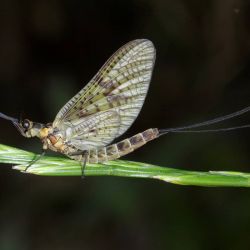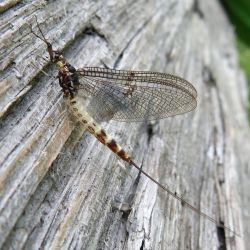This page will help you learn to identify Mayflies so when you encounter them you will be able to identify the insect and then match the hatch with the proper fly. Check out Jason Neuswanger aquatic insect site from Cornell University on Aquatic Insect guide to Entomology for Trout Fishing
The Order Ephemeroptera, known as the May Fly, consists of a total of 182 valid species in North Carolina representing 56 genera in 18 families.The immature stages of mayflies are aquatic. They generally live in unpolluted habitats with fresh, flowing water. Some species are active swimmers, others are flattened and cling to the underside of stones, a few are burrowers who dig U-shaped tunnels in the sand or mud. Most species are herbivorous. Their diet consists primarily of algae and other aquatic plant life scavenged from surrounding habitat. Some species mature quickly, in as little as four weeks, while others develop more slowly (one to four years per generation).
Once a mayfly completes development as a naiad, it leaves the aquatic environment, often rising to the water surface in a bubble of air. It quickly molts to a winged form (the sub imago) and flies to a nearby leaf or stem. The sub imago is a brief transitional stage that molts again into a sexually mature adult (imago). The imago usually has transparent wings and a smooth, shiny exoskeleton in contrast to the cloudy wings and dull, pubescent body of the sub imago. Mayflies are the only living insects that molt again after they have wings.
MayFly Entomology
Mayflies are hemimetabolous insects well known for their short-lived (ephemeral) adult phase, which usually lasts from two hours to three days. Mayflies are unique insects in that they have two adult stages. Both are winged, short-lived (1-2 hours to a maximum of 14 days) and do not feed (mouthparts are vestigial). The sub imago (dun) is a stage of sexual maturation in which the wings are semi-opaque and covered in minute hairs (microtrichia) with longer setae on the margins. Beneath the subimaginal cuticle the adult eyes, legs a nd genitalia are clearly visible. The mature adult (imago) that emerges when the sub imago molts has much longer legs and cerci, and wings that are clear and bare. Males generally fly in swarms that undulate in the air 5-15 meters above the ground. Females fly into the swarm and are quickly grabbed by a male. Copulation takes place in flight, and the female usually lays her clutch of eggs within minutes or hours. Males die shortly after mating; females usually die soon after oviposition.
In contrast to the imagoes, mayfly nymphs exhibit considerable diversity in appearance although many stream species are dorso-ventrally flattened. Mayfly nymphs go through a large number of molts as they grow, with most species having 15-25 instars















